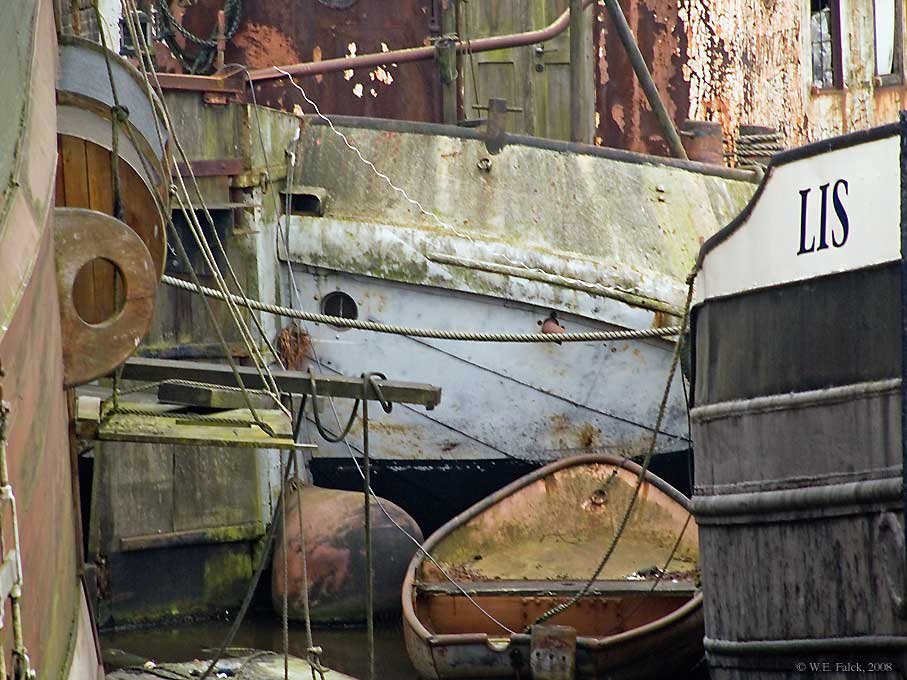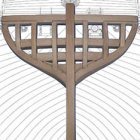Supplies of the Ship Modeler's Handbook are running out. Get your copy NOW before they are gone! Click on photo to order.
×
-
Posts
6,415 -
Joined
-
Last visited
Reputation Activity
-
 wefalck got a reaction from tkay11 in HMVS Cerberus 1870 by Louie da fly - FINISHED - approx 1:230 scale.
wefalck got a reaction from tkay11 in HMVS Cerberus 1870 by Louie da fly - FINISHED - approx 1:230 scale.
Love those Victorian-era warships, black-white-buff and still a lot of varnished wood and polished brass, much like the passenger steamers of the time. And indeed, they often had fanciful skylights and such.
The ventilators seem to have a rather peculiar shape. As to the position of ventilators: the really big ones are probably providing the draft for the boilers, smaller ones would be associated with living quarters and places like that.
The Dutch still have a couple of those monitor-like ships afloat, the BUFFLE and the SKORPIOEN, which may provide good pictorial reference for certain period details.
BUFFEL: https://debuffel.nl
From: https://onzemarinevloot.weebly.com/hrms-buffel.html
SCHORPIOEN: https://nl.wikipedia.org/wiki/Zr.Ms._Schorpioen_(1868)
From: my photograph
-
 wefalck got a reaction from Tony Hunt in HMVS Cerberus 1870 by Louie da fly - FINISHED - approx 1:230 scale.
wefalck got a reaction from Tony Hunt in HMVS Cerberus 1870 by Louie da fly - FINISHED - approx 1:230 scale.
Love those Victorian-era warships, black-white-buff and still a lot of varnished wood and polished brass, much like the passenger steamers of the time. And indeed, they often had fanciful skylights and such.
The ventilators seem to have a rather peculiar shape. As to the position of ventilators: the really big ones are probably providing the draft for the boilers, smaller ones would be associated with living quarters and places like that.
The Dutch still have a couple of those monitor-like ships afloat, the BUFFLE and the SKORPIOEN, which may provide good pictorial reference for certain period details.
BUFFEL: https://debuffel.nl
From: https://onzemarinevloot.weebly.com/hrms-buffel.html
SCHORPIOEN: https://nl.wikipedia.org/wiki/Zr.Ms._Schorpioen_(1868)
From: my photograph
-
 wefalck got a reaction from Roger Pellett in HMVS Cerberus 1870 by Louie da fly - FINISHED - approx 1:230 scale.
wefalck got a reaction from Roger Pellett in HMVS Cerberus 1870 by Louie da fly - FINISHED - approx 1:230 scale.
Love those Victorian-era warships, black-white-buff and still a lot of varnished wood and polished brass, much like the passenger steamers of the time. And indeed, they often had fanciful skylights and such.
The ventilators seem to have a rather peculiar shape. As to the position of ventilators: the really big ones are probably providing the draft for the boilers, smaller ones would be associated with living quarters and places like that.
The Dutch still have a couple of those monitor-like ships afloat, the BUFFLE and the SKORPIOEN, which may provide good pictorial reference for certain period details.
BUFFEL: https://debuffel.nl
From: https://onzemarinevloot.weebly.com/hrms-buffel.html
SCHORPIOEN: https://nl.wikipedia.org/wiki/Zr.Ms._Schorpioen_(1868)
From: my photograph
-
 wefalck got a reaction from GrandpaPhil in HMVS Cerberus 1870 by Louie da fly - FINISHED - approx 1:230 scale.
wefalck got a reaction from GrandpaPhil in HMVS Cerberus 1870 by Louie da fly - FINISHED - approx 1:230 scale.
Love those Victorian-era warships, black-white-buff and still a lot of varnished wood and polished brass, much like the passenger steamers of the time. And indeed, they often had fanciful skylights and such.
The ventilators seem to have a rather peculiar shape. As to the position of ventilators: the really big ones are probably providing the draft for the boilers, smaller ones would be associated with living quarters and places like that.
The Dutch still have a couple of those monitor-like ships afloat, the BUFFLE and the SKORPIOEN, which may provide good pictorial reference for certain period details.
BUFFEL: https://debuffel.nl
From: https://onzemarinevloot.weebly.com/hrms-buffel.html
SCHORPIOEN: https://nl.wikipedia.org/wiki/Zr.Ms._Schorpioen_(1868)
From: my photograph
-
 wefalck got a reaction from mtaylor in HMVS Cerberus 1870 by Louie da fly - FINISHED - approx 1:230 scale.
wefalck got a reaction from mtaylor in HMVS Cerberus 1870 by Louie da fly - FINISHED - approx 1:230 scale.
Love those Victorian-era warships, black-white-buff and still a lot of varnished wood and polished brass, much like the passenger steamers of the time. And indeed, they often had fanciful skylights and such.
The ventilators seem to have a rather peculiar shape. As to the position of ventilators: the really big ones are probably providing the draft for the boilers, smaller ones would be associated with living quarters and places like that.
The Dutch still have a couple of those monitor-like ships afloat, the BUFFLE and the SKORPIOEN, which may provide good pictorial reference for certain period details.
BUFFEL: https://debuffel.nl
From: https://onzemarinevloot.weebly.com/hrms-buffel.html
SCHORPIOEN: https://nl.wikipedia.org/wiki/Zr.Ms._Schorpioen_(1868)
From: my photograph
-
 wefalck reacted to Chuck in SOPHIA ROSE 1853 by Chuck - 3/8" scale - Block Island "Cowhorn" double-ender - prototype for Syren Ship Model Company prototype
wefalck reacted to Chuck in SOPHIA ROSE 1853 by Chuck - 3/8" scale - Block Island "Cowhorn" double-ender - prototype for Syren Ship Model Company prototype
The project has actually begun....
It will be built much like the Medway longboat kit and Queen Anne Barge kits..
More to follow but this is the keel. All finished up in Boxwood. As I mentioned this will proceed very slowly. I actually have over a year to complete it.
Dry fit after removing char. Basically just on the outside of the keel and inside of the notched pieces. These parts are precision laser cut so no need to sand or remove the char from the scarf joints.
On the stem, there is a sheave for hauling in various lines like the anchor cable. So a slot was filed into it which was centered. I followed the plans for its depth and shape. Then a laser cut sheave was added which is actually a working sheave. Slide it into the slot and stick a length of wire or in my case some 20lb black fishing line.
Thats it for now...
I hope you will follow with interest.
Chuck
-
 wefalck reacted to Chuck in SOPHIA ROSE 1853 by Chuck - 3/8" scale - Block Island "Cowhorn" double-ender - prototype for Syren Ship Model Company prototype
wefalck reacted to Chuck in SOPHIA ROSE 1853 by Chuck - 3/8" scale - Block Island "Cowhorn" double-ender - prototype for Syren Ship Model Company prototype
Many of you know that I am building the POF Speedwell currently. I also have several other projects underway but none of those are ready for a build log yet. These extra projects will not be updated very often and I plan on taking my time with them. This particular project is a commission of sorts. It will be made entirely of Boxwood because its a tiny open boat even at this scale. There are few models of these graceful common fishing boats out there. Thats a shame. But one I have seen and admired was made by Spencer Delrin. I have seen it many times and always said that I would build one. Now comes my chance.
No two Block Island Cowhorns were alike. These were not built to a plan at all. They were made over and over again locally and each time they were slightly different. There are plans available which were made by who else but Howard Chapelle. These are the plans I am using.
I have been researching them for months now. I have chosen to name this the Sophia Rose which was an actual cowhorn on block Island that was lost at sea in 1853. All hands were lost in a gail and the crew died trying to swim back to shore. There is an account of this in the Rhode Island Gazette Obituary from that time period...it was the local paper. It was owned by Barker Burnell and his brother Jonathan. My daughter's name is Sophia so I figured why not, although I wont tell her that the two brothers drowned and were lost at sea.
This will actually become a limited edition all boxwood kit which will be raffled off at a future Joint Clubs conference. I will make just 10 of these boxwood kits. Five for the Conference, and 3 for MSW members.....and 2 I will keep.
Although I may also release it later in Yellow cedar. The all-boxwood versions will only be made into 10 kits fully rigged.
A replica which is actually very accurate....
Chapelle's Plans
Spencer's Model...really beautiful...also at 3/8" scale.
And some old photos as these Cowhorn double enders were used right up until the 1900's
There were dozens on the Island every season (anywhere from 50 - 70) fishing. A common site from the 1820's through their prime in the 1850's and 60's.
-
 wefalck reacted to iMustBeCrazy in HMVS Cerberus 1870 by Louie da fly - FINISHED - approx 1:230 scale.
wefalck reacted to iMustBeCrazy in HMVS Cerberus 1870 by Louie da fly - FINISHED - approx 1:230 scale.
Possibly the same thing that keeps moving?
The wheelhouse is actually the binnacle-house (9). With the wheel at (19).
The binnacle-house becomes the binnacle-pergola.
A new compensated* waterproof binnacle is installed and the pergola is moved to between the funnel and ventilator.
* probably to allow the fitting of the two Nordenfelt machine guns.
-
 wefalck reacted to Louie da fly in HMVS Cerberus 1870 by Louie da fly - FINISHED - approx 1:230 scale.
wefalck reacted to Louie da fly in HMVS Cerberus 1870 by Louie da fly - FINISHED - approx 1:230 scale.
I just joined the local Men's Shed - this is a common set-up in Oz, where men can get together, talk about men's stuff, tell a lot of lies, and make stuff. The local one is in the woodworking section of a local high school which has now been converted to a community centre, and has an amazing array of equipment and facilities - carpenters' benches, planes, chisels, drill presses, bench and drop-saws, lathes of various sizes, thicknessers, disc sanders (my current favourite!) etc etc.
As it's a fairly informal community group they're always short of funds and they make things to sell, to fund their activities - timber cutting boards (bread-boards), birdhouses, that kind of thing.
It occurred to me that (not really wanting to make bird-houses, though I might be persuaded to make possum-boxes to put in trees to provide homes for the local wild-life), I should do something more in line with my own interests.
Which led to the HMVS Cerberus, a coastal monitor built in England in 1870 for the fledgling navy of the colony of Victoria, Australia. https://www.navy.gov.au/hmas-cerberus-hmvs
Fortunately, I was able to find this on-line:
Looking at the plans, I realised she could be made quite simply as a "bread and butter" model, cut from 10mm sheets of pine with my new Precious (scroll saw), with only a little fiddly work to do the additional bits of pieces - the masts and skylights etc (which I will probably make out of bamboo kitchen skewers of various sizes.) I blew the plan view up on the photocopier, and glued the copy onto a bit of pine I had lying around.
So, off I went, and here is the beginning of the build. The turrets were cut from the same sheet of pine, using a hole saw attached to my electric drill.
More to come.
Steven
PS: Dan Vadas (sadly missed) made a model of the Cerberus out of card - you can see the build log if you do a search).
-
 wefalck reacted to gjdale in The Shipyard at Foss' Landing (Diorama) by gjdale (Grant) - FINISHED - SierraWest - Scale 1:87 (HO)
wefalck reacted to gjdale in The Shipyard at Foss' Landing (Diorama) by gjdale (Grant) - FINISHED - SierraWest - Scale 1:87 (HO)
Thanks again for all the encouraging comments and the "likes".
Detailing the Diorama Scenes
The next task was to add the ballast to the rail tracks. I quickly discovered why most modellers will add the ballast before laying the tracks – it would have been much easier that way! Nevertheless, it didn’t prove to be too difficult. Once the ballast was down, I was able to start adding a secondary layer to the base, including the suggestion of some grass along the outer fence line. (The fence will be added in much later, but for the moment the holes for the fence posts are plugged with some scraps). The loading docks for the main building were also glued in place at this stage. In the picture below, one of the docks is being weighted down while the glue dries.
The next task was to create the Steam Box scene. In addition to the placement of the steam box, boiler and hand cart, I added a pile of sawdust that has been created from the blower under the saw table. As this is great fuel for the boiler furnace, a shovel can be seen in the saw dust pile. Several scraps of wood are also scattered about under the steam box.
It was then time to place some previously prepared castings around the Upper Yard shed. I struggled with this at first but eventually managed to refine my technique to get the castings embedded in the ground. Here is a series of shots from all four sides of the Upper Yard Shed.
The Saw Shed itself was enhanced by the addition of some freshly delivered lumber that has just been unloaded from the rail siding and stacked, ready for processing.
The back of the Saw Shed received a few castings, as well as a little shrubbery.
The opposite end of the Saw Shed received a few scraps of lumber off-cuts after processing in the shed.
In the above picture and the next, you can also see the beginnings of the entry road, which includes creating a crossing for the rail line. There is more work to be done on this.
The Derrick Dock will be the next to receive some detailing before the main buildings are placed and the details added around it. Still a long way to go, but I’m fairly happy with progress thus far.
-
 wefalck got a reaction from druxey in La Créole 1827 by archjofo - Scale 1/48 - French corvette
wefalck got a reaction from druxey in La Créole 1827 by archjofo - Scale 1/48 - French corvette
... and one has to remember that in real life this was done by a whole crew of riggers or seamen - while here it is done by just one man 😵💫
-
 wefalck got a reaction from Hubac's Historian in La Créole 1827 by archjofo - Scale 1/48 - French corvette
wefalck got a reaction from Hubac's Historian in La Créole 1827 by archjofo - Scale 1/48 - French corvette
... and one has to remember that in real life this was done by a whole crew of riggers or seamen - while here it is done by just one man 😵💫
-
 wefalck got a reaction from mtaylor in Elementary school clear glue?
wefalck got a reaction from mtaylor in Elementary school clear glue?
When it smells, than it is good and works 🤪
My father was a chemist (and I am a half-chemist too) and he taught me early on respect for chemicals, but not to have fear ...
-
 wefalck got a reaction from mtaylor in Tiller tackle
wefalck got a reaction from mtaylor in Tiller tackle
This is a common problem with amateur historians, they collect large amounts of knowledge from which they quote, but then are not able (or willing) to give proper references ...
It will be near impossible to prove a date, when steering wheels were introduced, but one may be able to pin down a period, when the whipstaff definitely disappeared.
One should dive into the reserve collections of the various maritime museums. They usually have functional models for innovations that were proposed to the Admiralty or to the (predecessors of) patent offices. The wedging device on the tiller of LADY WASHINGTON could be a case like that. I have not seen that before - that's why an open rope and a pin or something to belay the rope was used.
-
 wefalck got a reaction from Bob Cleek in Elementary school clear glue?
wefalck got a reaction from Bob Cleek in Elementary school clear glue?
When it smells, than it is good and works 🤪
My father was a chemist (and I am a half-chemist too) and he taught me early on respect for chemicals, but not to have fear ...
-
 wefalck got a reaction from bridgman in Tiller tackle
wefalck got a reaction from bridgman in Tiller tackle
This is a common problem with amateur historians, they collect large amounts of knowledge from which they quote, but then are not able (or willing) to give proper references ...
It will be near impossible to prove a date, when steering wheels were introduced, but one may be able to pin down a period, when the whipstaff definitely disappeared.
One should dive into the reserve collections of the various maritime museums. They usually have functional models for innovations that were proposed to the Admiralty or to the (predecessors of) patent offices. The wedging device on the tiller of LADY WASHINGTON could be a case like that. I have not seen that before - that's why an open rope and a pin or something to belay the rope was used.
-
 wefalck got a reaction from jose_b in La Créole 1827 by archjofo - Scale 1/48 - French corvette
wefalck got a reaction from jose_b in La Créole 1827 by archjofo - Scale 1/48 - French corvette
... and one has to remember that in real life this was done by a whole crew of riggers or seamen - while here it is done by just one man 😵💫
-
 wefalck got a reaction from GrandpaPhil in La Créole 1827 by archjofo - Scale 1/48 - French corvette
wefalck got a reaction from GrandpaPhil in La Créole 1827 by archjofo - Scale 1/48 - French corvette
... and one has to remember that in real life this was done by a whole crew of riggers or seamen - while here it is done by just one man 😵💫
-
 wefalck got a reaction from Canute in Elementary school clear glue?
wefalck got a reaction from Canute in Elementary school clear glue?
When it smells, than it is good and works 🤪
My father was a chemist (and I am a half-chemist too) and he taught me early on respect for chemicals, but not to have fear ...
-
 wefalck got a reaction from Ras Ambrioso in Pelican 1943 by FriedClams - 1:48 - Eastern-Rig Dragger
wefalck got a reaction from Ras Ambrioso in Pelican 1943 by FriedClams - 1:48 - Eastern-Rig Dragger
Had to do quite a bit of travelling recently and only had time to occasionally glance over MSW - so I missed the beginning of this new project.
The subject is not really 'my' period and I am not a great fan of scallops either - however, I am looking forward again to a nice exercise in first-class modelling 👍
-
 wefalck reacted to Wreck1919 in SMS Karlsruhe by Wreck1919 - 1/100
wefalck reacted to Wreck1919 in SMS Karlsruhe by Wreck1919 - 1/100
Thanks Nils - the upper bridge received some equipment. Handwheels and optics still missing.
-
 wefalck got a reaction from thibaultron in Tiller tackle
wefalck got a reaction from thibaultron in Tiller tackle
This is a common problem with amateur historians, they collect large amounts of knowledge from which they quote, but then are not able (or willing) to give proper references ...
It will be near impossible to prove a date, when steering wheels were introduced, but one may be able to pin down a period, when the whipstaff definitely disappeared.
One should dive into the reserve collections of the various maritime museums. They usually have functional models for innovations that were proposed to the Admiralty or to the (predecessors of) patent offices. The wedging device on the tiller of LADY WASHINGTON could be a case like that. I have not seen that before - that's why an open rope and a pin or something to belay the rope was used.
-
 wefalck got a reaction from kurtvd19 in Okesa 1918 by OkesaBuilder - FINISHED - Scale 1:96 - Ferris Type WWI Wooden Steamer built in Portland Maine
wefalck got a reaction from kurtvd19 in Okesa 1918 by OkesaBuilder - FINISHED - Scale 1:96 - Ferris Type WWI Wooden Steamer built in Portland Maine
Well, just scrolled through the entire retrospective log - truly impressive 👍
-
 wefalck got a reaction from thibaultron in Elementary school clear glue?
wefalck got a reaction from thibaultron in Elementary school clear glue?
When it smells, than it is good and works 🤪
My father was a chemist (and I am a half-chemist too) and he taught me early on respect for chemicals, but not to have fear ...
-
 wefalck got a reaction from druxey in SMS WESPE 1876 by wefalck – FINISHED - 1/160 scale - Armored Gunboat of the Imperial German Navy - as first commissioned
wefalck got a reaction from druxey in SMS WESPE 1876 by wefalck – FINISHED - 1/160 scale - Armored Gunboat of the Imperial German Navy - as first commissioned
Thank you very much, gentlemen, for your kind comments.
@amateur Well, when you look really close, it is not always as perfect as you may think. However, I try to use the airbrush, whenever possible, because this gives an even coating. Spraying white is difficult due to relative coarse pigment particles, black on the other hand is easy, because these particles are probably the smallest. Everything else is somewhere in between.
I am mainly using Vallejo model air and Schmincke acrylics. I also tend to use less glue, but rather varnish to cement parts in place. Most parts have some sort of mechanical lock as well, so that the glue just provides added strength. The varnish can also cleaned up with solvent - when the cementing takes place before painting.
Forgot to mention: some time ago @Toolmaker sent me a PM about braiding wires to imitate chain, a method that looked quite convincing. I tried it with the 0.06 mm Konstantan-wire I need to use and this is just to flimsy. It breaks very easily, when handled and I was not successful at that size. I gather with wire of 0.1 mm diametre or above it should work. In order to get the 'links' even one needs to pull quite a bit.











